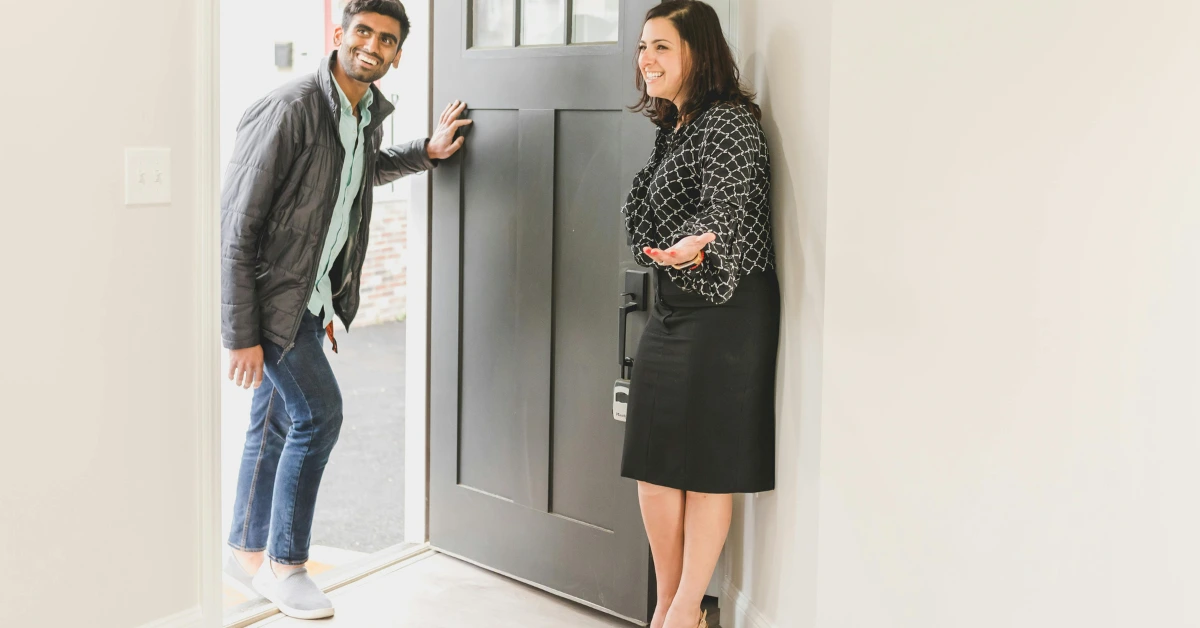Wondering what you must know before buying a rental property?
That’s what you’ll learn in this article.
As a seven-figure real estate investor myself, I’ll cover the seven steps to set yourself up for success. If you want to invest so you can do things like…
- Quit your 9-5
- Build a full-time income on the side
- And travel more
…Then keep reading. You’ll learn what mistakes to avoid, how to find the right property, and how to build a highly profitable rental property portfolio.
Let’s dive in!
Here are the steps:
1. Clarify your investment goals
Before buying a rental property, clarify your goals. Are you looking for rental income, property appreciation, or both? Understanding your goals helps you choose the right property and financing strategy.
Next, assess your financial situation:
- Can you afford a down payment?
- How much risk are you comfortable taking?
There are plenty of strategies you can use to invest in rental properties – such as long-term, vacation, and commercial rentals.
For a full breakdown, watch this video:
In my experience, the best strategy for beginners is to rent out single-family homes. And to maximize rental income, consider renting out individual rooms instead of the entire property.
For example, I invest in larger properties and rent rooms to college students to increase returns.
But if you’re starting with a smaller budget, house hacking—living in one unit while renting out the rest—can be a great entry point.
Once you’ve set your goals, the next step is market research.
2. Conduct market research
Investing in a familiar area can reduce risk, but it’s crucial to analyze rental demand before making a decision. Look at key factors that affect property value and tenant interest.
Ask these questions when researching a rental market:
- Property taxes – How much will you pay annually?
- School districts – Are they highly rated? Do they attract families?
- Crime rates – Is the neighborhood safe?
- Amenities & transportation – Are there nearby grocery stores, parks, or public transit?
As you evaluate your findings, consider your ideal renter. Are you targeting families, professionals, or students? Their needs—like proximity to schools, job centers, or nightlife—should guide your investment choice.
3. Analyze your finances
Before buying a rental property, assess your financial situation to ensure you can cover both upfront and ongoing costs.
Key expenses to consider:
- Purchase price – How much can you afford to invest?
- Insurance & property management fees – Required for protecting your investment and handling tenant relations.
- Maintenance & repairs – Regular upkeep and unexpected expenses.
- Renovations – Costs for improving property value and attracting tenants.
If you plan to finance your property with a mortgage, check lender requirements:
- Minimum credit score – Typically 620+ for conventional loans.
- Down payment – Often 15-25% for investment properties.
For a profitable investment, your rental income should cover all expenses and generate positive cash flow each month.

4. Legal and regulatory considerations
Before buying a rental property, understand the laws and regulations that impact real estate investors. Staying compliant helps you avoid legal issues and protects your investment.
A few key legal factors to consider include:
- Fair housing laws – Landlords cannot discriminate based on age, race, religion, disability, or other protected factors. Ensure your rental listings and tenant selection process follow these guidelines.
- Building codes & safety regulations – Properties must meet local safety standards, which often include:
-
- Smoke detectors
- Carbon monoxide detectors
- Proper electrical and plumbing systems
- Rental laws & lease agreements – Understand tenant rights, eviction rules, and security deposit laws in your state.
If you’re unsure about legal requirements, consulting a lawyer can help you avoid costly mistakes.
Next up? Selecting the right property.
5. Select the right property
Choosing the right rental property depends on your investment goals, risk tolerance, and target renters. Here’s how to evaluate your options effectively:
1. Define your investment goals
- Cash flow: Generate steady rental income
- Appreciation: Buy properties in areas with rising values
- Short-term vs. long-term rental: Decide between traditional rentals and Airbnb-style short-term rentals
2. Choose the right property type
- Single-family homes – Easier to manage and lower turnover
- Multi-family properties – Higher cash flow, more tenants, but increased management
- Condos – Less maintenance, but HOA fees may cut into profits
- Commercial properties – Higher income potential but longer vacancies
3. Research the location
Look for areas with:
- Strong rental demand – Check local vacancy rates
- Job growth & economic stability – More jobs attract more tenants
- Good school districts – Increases desirability for families
- Low crime rates – Ensures tenant safety and property value
- Public transport & amenities – Increases rental appeal
For a full breakdown, take a look at this short video:
4. Know your target renter
Ask yourself: Who am I renting to, and what do they need?
For example, in my case, I know my target renters (college students) are looking for a room near campus, so I invest in single-family housing in college towns.
Other examples include:
- Young professionals → Urban apartments near transit
- Families → Spacious homes in good school districts
5. Run the numbers
Before buying, calculate:
- Rental income – Expected monthly rent
- Expenses – Mortgage, insurance, taxes, maintenance
- Cash flow – Income minus expenses (should be positive)
- Cap rate – Measures return on investment
6. Inspect the property
- Hire an inspector to check for major repairs.
- Assess age, condition, and potential upgrades.
By evaluating these factors, you’ll select a profitable, low-risk rental property that aligns with your investment strategy.
Next step: Research financing options to secure the best deal.
6. Manage your risks
Owning a rental property comes with risks, but proper planning can help you minimize them. The two biggest concerns are:
- Vacancies – No tenants mean no rental income
- Unexpected expenses – Repairs and legal issues can eat into profits
To reduce these risks:
- Verify income and employment
- Check credit and rental history
- Require security deposits to cover potential damages
Build an emergency fund
- Set aside at least 3-6 months of expenses for unexpected repairs or vacancies
- Covers property damage from fire, storms, and vandalism
- Includes liability protection in case a tenant gets injured on the property (for example, slipping on an icy walkway)
By taking these steps, you can protect your investment and ensure steady cash flow from your rental property.
7. Manage your property
Effective property management ensures smooth operations, minimizes tenant issues, and protects your investment. Your key responsibilities include:
- Tenant screening
- Lease agreements
- Maintenance and repairs
You have two options for property management:
- Self-management – Saves money and allows full control
- Hiring a property manager – Reduces workload but costs 8-12% of monthly rent
I personally self-manage my properties and use a strategy I call “tenant empowerment.”
Which means that instead of handling every issue myself, I give tenants clear guidelines on how to manage small problems.
For example:
- If there’s a leak, they call a plumber directly instead of waiting for me
- If a lightbulb burns out, they replace it themselves
This system reduces delays, speeds up problem-solving, and keeps my involvement minimal.
In other words: by setting clear expectations, you can manage a rental efficiently while keeping your time investment low.

What are the pros and cons of owning rental property?
Investing in rental properties can be a great way to build wealth, but it also comes with challenges. Below are the key benefits and risks to consider before buying.
Pros
The pros are the following:
- Monthly income: Once your property is rented, you receive consistent rental income, which can serve as passive cash flow. This income often covers your mortgage, property taxes, and maintenance costs, with extra profit left over.
- Property appreciation: Real estate tends to increase in value over time, even if you don’t make upgrades. As market prices rise, your property builds equity, allowing you to sell for a higher profit in the future.
- Tax benefits: As a real estate investor, you can be eligible for a variety of property tax breaks to reduce how much you owe on your tax return.
- Leverage to build wealth: Unlike stocks, real estate allows you to use leverage—taking out a mortgage to buy property with a relatively small down payment. This means you can own a high-value asset with less upfront capital.
Cons
The cons are the following:
- Vacancies: If a unit sits empty, you lose rental income but still have to cover the mortgage, property taxes, and maintenance. That’s why marketing your property and screening tenants is essential.
- Tenant management: Having tenants can involve conflict and disagreements, which you’re in charge of handling as a landlord.
Frequently asked questions about buying rental property
What type of rental property is most profitable?
Renting by the room is one of the most profitable rental strategies. By renting on a per-bedroom basis, you can earn significantly more than by renting an entire house to one person.
How do you know if a rental property is a good investment?
A good rental property investment generates positive cash flow, appreciates over time, and aligns with market demand. To evaluate a property, calculate its rental income, subtract all expenses (mortgage, taxes, maintenance), and ensure it still produces profit. Additionally, look for low vacancy rates, job growth, and desirable amenities in the area to attract long-term tenants.
What is the 2% rule for investment property?
The 2% rule is a rental property guideline that helps investors assess cash flow potential. According to this rule, a property is more likely to generate positive cash flow if the monthly rent is at least 2% of the purchase price.
What is the 50% rule in rental property?
The 50% rule is a budgeting guideline that helps investors estimate operating expenses. It suggests that 50% of your gross rental income should be allocated to expenses (excluding mortgage payments).
What’s next?
And there you have it: exactly what to know before buying a rental property.
As you can see, investing takes preparation, but the payoff can be huge. In my case, it meant being able to quit my job and retire in my early thirties.
Want the same, but not sure how to start?
If you’re serious about becoming a real estate investor, check out what I offer here.


